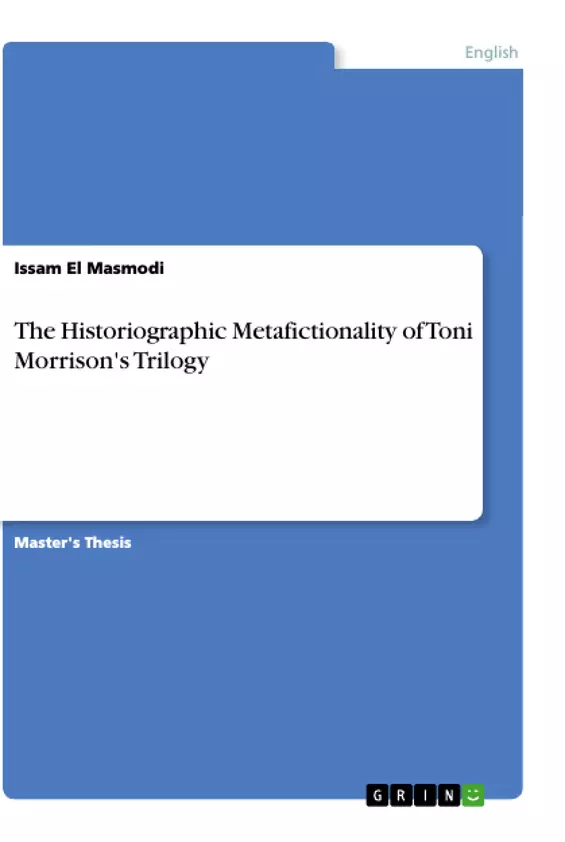The aim of the following dissertation is to prove the postmodernity of Morrison’s work. It is an attempt to underline the postmodern implications of Morrison’s trilogy including "Beloved" (1987), "Jazz" (1992), and "Paradise" (1998). This is why; the following research finds it useful to rely on Linda Hutcheon’s seminal work of "A Poetics of Postmodernism" (1988) as a guiding thread in the study of Morrison’s trilogy. The originality of the following dissertation lies in the fact that Hutcheon’s guiding theoretical work has come into being before the writing of Morrison’s trilogy, precisely one year after the publication of Morrison’s first novel of the trilogy that is Beloved. The present dissertation is an academic attack on the critics who exclude Morrison while discussing novels under the category of postmodern fiction. Morrison is usually approached from different theoretical frameworks, mainly black feminism, narratology, critical race theory, psychoanalysis and so on. However, the postmodern post-colonial Morrison has always been doomed to neglect. Hutcheon’s notion of historiographic metafiction is an umbrella term that describes Morrison’s postmodernity. The main aim of the dissertation is to simplify and thus breaks Hutcheon’s theoretical work into three main chapters namely subjectivity, palimpsests and magic realism with their implication in Morrison’s trilogy.
The dissertation is supposed to be made up of four chapters. However, for some academic reasons, it was necessary to omit the first chapter, which is dedicated to Morrison’s use of metafiction. Therefore, the reader will find out that the dissertation rely heavily on the historiographic dimension of Hutcheon’s A Poetics of Postmodernism while neglecting its self-reflexive aspect. Nevertheless, the reader can find some implications of metafiction in the introduction. At last but not least, the last chapter of magic realism is an attempt to supply the limitations of Hutcheon’s seminal work on postmodern fiction by arguing that magic realism is part and parcel of Morrison’s trilogy and thus of historiographic metafiction.
Inhaltsverzeichnis (Table of Contents)
- Abstract
- Introduction
- Chapter I. Subjectivity / Posmodern Blackness
- Intersectionality
- Quest for a self
- Deconstructing Subjectivity
- Chapter II. Palimpsests
- Paratext
- Signifyin(g) on Jazzthetics
- Parody
- Jazz an inverted Gatsby
- Pastiche
- Beloved vs. Hucklberry Finn
- Paradise vs. On the Road
- Chapter III: Magic realism
- Incredulity towards realism
- Hauntology
- Magical realism as a postcolonial counter-discourse
- Conclusion
- Work cited
Zielsetzung und Themenschwerpunkte (Objectives and Key Themes)
The primary objective of this dissertation is to demonstrate the postmodern nature of Toni Morrison’s work. It aims to highlight the postmodern implications of Morrison’s trilogy, including Beloved (1987), Jazz (1992), and Paradise (1998). Drawing on Linda Hutcheon’s seminal work, A Poetics of Postmodernism (1988), the dissertation explores the intersection of postmodernism and Morrison’s literary style.
- Postmodernism in Morrison’s work
- Historiographic metafiction
- Black feminism and critical race theory
- Magic realism and postcolonial discourse
- Language and the construction of meaning
Zusammenfassung der Kapitel (Chapter Summaries)
Chapter I, “Subjectivity / Postmodern Blackness,” delves into the complexities of subjectivity, particularly in relation to African American experiences. It examines how Morrison’s work explores themes of intersectionality, the quest for self-identity, and the deconstruction of traditional notions of subjectivity. Chapter II, “Palimpsests,” focuses on the concept of palimpsests as a key feature of Morrison’s literary style. It analyzes Morrison’s use of paratext, signifiers, parody, and pastiche to create a rich and layered narrative.
Chapter III, “Magic Realism,” investigates the role of magic realism in Morrison’s trilogy. It explores how Morrison employs elements of incredulity towards realism, hauntology, and magic realism as a postcolonial counter-discourse to challenge traditional narratives and provide a unique perspective on African American history and culture.
Schlüsselwörter (Keywords)
This dissertation explores the intersection of postmodernism and African American literature, focusing on Toni Morrison’s trilogy. The central themes revolve around historiographic metafiction, subjectivity, intertextuality, parody, pastiche, postmodernism, post-colonialism, magic realism, intersectionality, and hauntology. These key concepts are used to analyze Morrison’s literary style and explore the complexities of African American experiences.
- Citar trabajo
- Issam El Masmodi (Autor), 2021, The Historiographic Metafictionality of Toni Morrison's Trilogy, Múnich, GRIN Verlag, https://www.grin.com/document/1050358



